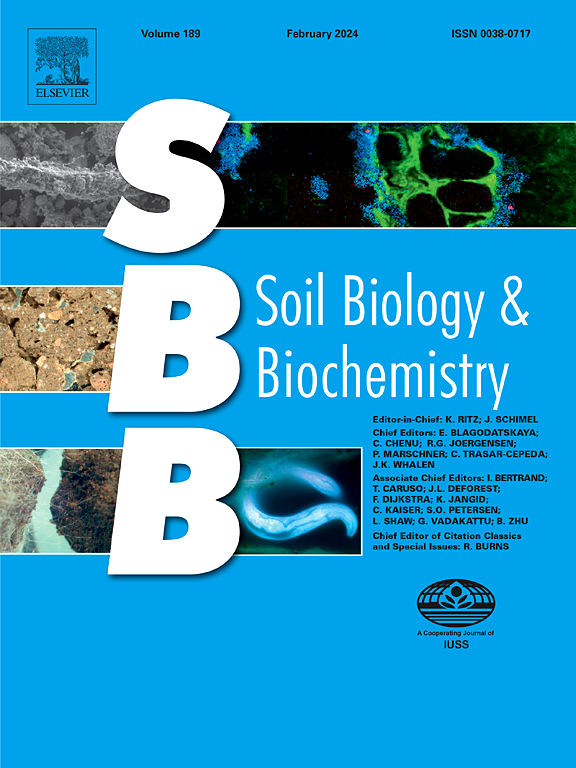森林土壤生物群的减少会影响树木的性能,但不会影响温室气体通量
IF 9.8
1区 农林科学
Q1 SOIL SCIENCE
引用次数: 0
摘要
土壤生物群落对生态系统的功能至关重要,但土壤生物群落的减少对根系相关群落、树木性能和温室气体通量的影响仍不清楚。本研究探讨了幼林和成熟森林中不同大小的土壤生物群如何影响桤木(Alnus glutinosa)的表现、根相关群落组成和温室气体通量。我们使用幼林和成熟林发育阶段的土壤群落分馏物(湿筛分过 250、20、11 和 3 μm)作为接种物,进行了中观宇宙实验。结果表明,根相关群落的组成受森林发育阶段的影响,但与群落组分的大小无关。接种成熟森林中尺寸最大的部分会对树木生长产生负面影响,这可能是由于植物与土壤生物群之间的竞争加剧所致。此外,尽管提供的群落组成不同,但温室气体通量并没有受到群落大小或森林发育阶段的显著影响。总之,我们的研究表明,尽管初始接种物不同,但谷氨酰氨对根相关群落的组成有强烈的选择性,而且这种组成随生态系统发展阶段的不同而变化,会影响树木的表现,但不会影响温室气体通量。本文章由计算机程序翻译,如有差异,请以英文原文为准。
Reduction of forest soil biota impacts tree performance but not greenhouse gas fluxes
Soil communities are essential to ecosystem functioning, yet the impact of reducing soil biota on root-associated communities, tree performance, and greenhouse gas (GHG) fluxes remains unclear. This study examines how different size fractions of soil biota from young and mature forests influence Alnus glutinosa performance, root-associated community composition, and GHG fluxes. We conducted a mesocosm experiment using soil community fractions (wet sieving through 250, 20, 11, and 3 μm) from young and mature forest developmental stages as inocula. The results indicate that the root-associated community composition was shaped by forest developmental stage but not by the size of the community fractions. Inoculation with the largest size fraction from mature forests negatively affected tree growth, likely due to increased competition between the plants and soil biota. In addition, GHG fluxes were not significantly impacted by either size fraction or forest developmental stage despite the different community composition supplied. Overall, our research indicates that A. glutinosa strongly selects the composition of the root-associated community, despite differences in the initial inoculum, and this composition varies depending on the stage of ecosystem development, impacting the performance of the trees but not GHG fluxes.
求助全文
通过发布文献求助,成功后即可免费获取论文全文。
去求助
来源期刊

Soil Biology & Biochemistry
农林科学-土壤科学
CiteScore
16.90
自引率
9.30%
发文量
312
审稿时长
49 days
期刊介绍:
Soil Biology & Biochemistry publishes original research articles of international significance focusing on biological processes in soil and their applications to soil and environmental quality. Major topics include the ecology and biochemical processes of soil organisms, their effects on the environment, and interactions with plants. The journal also welcomes state-of-the-art reviews and discussions on contemporary research in soil biology and biochemistry.
 求助内容:
求助内容: 应助结果提醒方式:
应助结果提醒方式:


